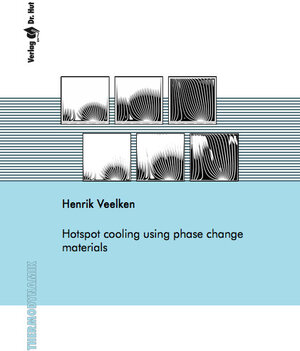
×
![Buchcover ISBN 9783843947282]()
Hotspot cooling using phase change materials
von Henrik VeelkenMiniaturization of electronic components has dramatically increased the heat flux densities during the last decades with two main challenges: removing very high heat fluxes of up to 100 W/cm^2 and finding a cooling-solution for highly non-uniform power dissipation. While the former has gained much attention in latest research activities, the latter has not gained as much. Phase change material(PCM) based cooling systems show promising cooling performances in setups with periodical or finite operational time.
Within commercially available PCM's, paraffins have high melting enthalpies and minor or no disadvantages like subcooling, phase separation, high costs or corrosion. Unfortunately, paraffins have a very low heat conductivity, which makes these impractical to be used without any thermal conductivity enhancer. One can choose to use a frame fin structure made of aluminum or copper. The resulting thermal energy storage is called composite latent heat storage(CLHS). A naturally emerging question is, weather these fin structures should depend on the heat load.
A fin positioning optimization using a genetic algorithm suggests an even distribution of fins at the mid height of the CLHS. CLHS with internal fins based on a reference temperature are optimized using three different objectives with an optimization potential of up to 5.4%. An optimal control based approach on the assessment of a CLHS is also carried out.
A total of nine CLHS are tested on a test rig for two heat load examples. Optimized CLHS have an up to 7.7K lower temperature of the electronic than a straight fin CLHS, leading to a reduced failure rate of up to 38%. These optimized fin structures perform well on the heat load, for which they were designed for, but poorly for the other heat load. Simulations and experiments show in both heat load cases good agreement in the relative prediction of the performances.
Within commercially available PCM's, paraffins have high melting enthalpies and minor or no disadvantages like subcooling, phase separation, high costs or corrosion. Unfortunately, paraffins have a very low heat conductivity, which makes these impractical to be used without any thermal conductivity enhancer. One can choose to use a frame fin structure made of aluminum or copper. The resulting thermal energy storage is called composite latent heat storage(CLHS). A naturally emerging question is, weather these fin structures should depend on the heat load.
A fin positioning optimization using a genetic algorithm suggests an even distribution of fins at the mid height of the CLHS. CLHS with internal fins based on a reference temperature are optimized using three different objectives with an optimization potential of up to 5.4%. An optimal control based approach on the assessment of a CLHS is also carried out.
A total of nine CLHS are tested on a test rig for two heat load examples. Optimized CLHS have an up to 7.7K lower temperature of the electronic than a straight fin CLHS, leading to a reduced failure rate of up to 38%. These optimized fin structures perform well on the heat load, for which they were designed for, but poorly for the other heat load. Simulations and experiments show in both heat load cases good agreement in the relative prediction of the performances.


